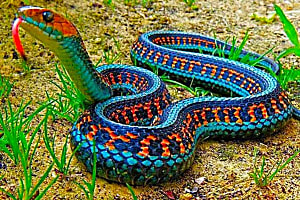At around 9am, as the sun's beams begin to overpower the shadows one by one in the dense Cotigao wildlife sanctuary in Canacona, a stray butterfly comes into view, flitting around all alone. Suddenly, you notice that your new winged acquaintance has company. It is engaged in a mating game with a partner. And then, out of the blue, there are several of varied species, dancing around you, seemingly vying for your attention.
These winged wonders are there for all to see within the Butterfly Park inside the Cotigao wildlife sanctuary, the only such state-run park in Goa, and probably one of the most underexplored of the state's attractions. The park is open for exploration for free. And with the park records showing that no less than 180 species of butterflies have been spotted at the Butterfly Park, a visit to the park is an opportunity of a lifetime for both the novice and butterfly enthusiast. The novice may initially find it a bewildering sight; to be able to see so many of these winged wonders in such varied patterns and hues at one go. That is till the helpful and informative forest rescuer Deepak Hanskar steps in. "Except from April to July, the rest of the year is ideal to spot butterflies at the park. The best time is from 9am to 12noon. This is when the dew seeps into flowers and is a good time for butterflies to look for nectar, and the best time for nature lovers to catch the butterflies in action," says Hanskar.
The forest officials meticulously jot down names of the butterflies spotted at the park by them each day. The register records no less than 50 names on any given day. The Tamil Cat's Eye, which can be seen at the park, is one of the butterflies whose presence in Goa has been recently identified. The world's largest moth — the Atlas moth — can be seen here, as also Asia's largest butterfly, the Southern Birdwing, if you are one of the luckier visitors that is. The Malabar Banded Swallowtail is one of the rarest sights one can catch at the park.
The secret to retaining free willed creatures like butterflies within the park's jurisdiction are the host plants and nectar plants that have been carefully cultivated at the park. These ensure that each of the different species of butterflies have all that they need within the park boundaries, giving them no reason to leave. It is not easy though. Forest rescuers like Hanskar go looking for butterfly eggs on plants (you need microscopic vision to spot these). The eggs along with the leaf on which they are laid are allowed to develop in a controlled environment. During the pupation stage, each butterfly is fed plants as per the species' requirement.
Once the caterpillar develops into a butterfly, it is freed. Care is taken that host plants and nectar plants, as per their needs, are already grown at the park for the butterfly to feed on. "The uglier the caterpillar, the more beautiful the butterfly," grins Hanskar. The park was first conceptualised under range forest officer (RFO) Vilas Gawas, and is being overseen by Vikramaditya Gaonkar now. "As of now we get a very few, niche visitors, who are specifically interested in researching butterflies. Butterflies have a very complex lifecycle, which may be difficult for others to grasp," says an official.But there is enough to excite anyone's curiosity at the park, if only you do sufficient background research before a visit. There are so many fascinating facts to learn about butterflies and then watch them yourself at the park. For instance, butterflies first scratch the plant locally known as 'kulkulo' with their legs to release the sap from the plant, which then serves as a much favoured food for the butterflies. Once one butterfly rubs the kulkulo plant to release the sap, it attracts more than a dozen at once. The Blue Oakleaf resembles a leaf more than it does a butterfly, in one of nature's most deceptive acts. What better place to learn about these nature's gifts then the Cotigao wildlife sanctuary's Butterfly Park.
Once the caterpillar develops into a butterfly, it is freed. Care is taken that host plants and nectar plants, as per their needs, are already grown at the park for the butterfly to feed on.
"The uglier the caterpillar, the more beautiful the butterfly," grins Hanskar. The park was first conceptualised under range forest officer (RFO) Vilas Gawas, and is being overseen by Vikramaditya Gaonkar now. "As of now we get a very few, niche visitors, who are specifically interested in researching butterflies. Butterflies have a very complex lifecycle, which may be difficult for others to grasp," says an official.But there is enough to excite anyone's curiosity at the park, if only you do sufficient background research before a visit.
There are so many fascinating facts to learn about butterflies and then watch them yourself at the park. For instance, butterflies first scratch the plant locally known as 'kulkulo' with their legs to release the sap from the plant, which then serves as a much favoured food for the butterflies. Once one butterfly rubs the kulkulo plant to release the sap, it attracts more than a dozen at once. The Blue Oakleaf resembles a leaf more than it does a butterfly, in one of nature's most deceptive acts. What better place to learn about these nature's gifts then the Cotigao wildlife sanctuary's Butterfly Park.
These winged wonders are there for all to see within the Butterfly Park inside the Cotigao wildlife sanctuary, the only such state-run park in Goa, and probably one of the most underexplored of the state's attractions. The park is open for exploration for free. And with the park records showing that no less than 180 species of butterflies have been spotted at the Butterfly Park, a visit to the park is an opportunity of a lifetime for both the novice and butterfly enthusiast. The novice may initially find it a bewildering sight; to be able to see so many of these winged wonders in such varied patterns and hues at one go. That is till the helpful and informative forest rescuer Deepak Hanskar steps in. "Except from April to July, the rest of the year is ideal to spot butterflies at the park. The best time is from 9am to 12noon. This is when the dew seeps into flowers and is a good time for butterflies to look for nectar, and the best time for nature lovers to catch the butterflies in action," says Hanskar.
The forest officials meticulously jot down names of the butterflies spotted at the park by them each day. The register records no less than 50 names on any given day. The Tamil Cat's Eye, which can be seen at the park, is one of the butterflies whose presence in Goa has been recently identified. The world's largest moth — the Atlas moth — can be seen here, as also Asia's largest butterfly, the Southern Birdwing, if you are one of the luckier visitors that is. The Malabar Banded Swallowtail is one of the rarest sights one can catch at the park.
The secret to retaining free willed creatures like butterflies within the park's jurisdiction are the host plants and nectar plants that have been carefully cultivated at the park. These ensure that each of the different species of butterflies have all that they need within the park boundaries, giving them no reason to leave. It is not easy though. Forest rescuers like Hanskar go looking for butterfly eggs on plants (you need microscopic vision to spot these). The eggs along with the leaf on which they are laid are allowed to develop in a controlled environment. During the pupation stage, each butterfly is fed plants as per the species' requirement.
Once the caterpillar develops into a butterfly, it is freed. Care is taken that host plants and nectar plants, as per their needs, are already grown at the park for the butterfly to feed on. "The uglier the caterpillar, the more beautiful the butterfly," grins Hanskar. The park was first conceptualised under range forest officer (RFO) Vilas Gawas, and is being overseen by Vikramaditya Gaonkar now. "As of now we get a very few, niche visitors, who are specifically interested in researching butterflies. Butterflies have a very complex lifecycle, which may be difficult for others to grasp," says an official.But there is enough to excite anyone's curiosity at the park, if only you do sufficient background research before a visit. There are so many fascinating facts to learn about butterflies and then watch them yourself at the park. For instance, butterflies first scratch the plant locally known as 'kulkulo' with their legs to release the sap from the plant, which then serves as a much favoured food for the butterflies. Once one butterfly rubs the kulkulo plant to release the sap, it attracts more than a dozen at once. The Blue Oakleaf resembles a leaf more than it does a butterfly, in one of nature's most deceptive acts. What better place to learn about these nature's gifts then the Cotigao wildlife sanctuary's Butterfly Park.
Once the caterpillar develops into a butterfly, it is freed. Care is taken that host plants and nectar plants, as per their needs, are already grown at the park for the butterfly to feed on.
"The uglier the caterpillar, the more beautiful the butterfly," grins Hanskar. The park was first conceptualised under range forest officer (RFO) Vilas Gawas, and is being overseen by Vikramaditya Gaonkar now. "As of now we get a very few, niche visitors, who are specifically interested in researching butterflies. Butterflies have a very complex lifecycle, which may be difficult for others to grasp," says an official.But there is enough to excite anyone's curiosity at the park, if only you do sufficient background research before a visit.
There are so many fascinating facts to learn about butterflies and then watch them yourself at the park. For instance, butterflies first scratch the plant locally known as 'kulkulo' with their legs to release the sap from the plant, which then serves as a much favoured food for the butterflies. Once one butterfly rubs the kulkulo plant to release the sap, it attracts more than a dozen at once. The Blue Oakleaf resembles a leaf more than it does a butterfly, in one of nature's most deceptive acts. What better place to learn about these nature's gifts then the Cotigao wildlife sanctuary's Butterfly Park.
Get latest news & live updates on the go on your pc with News App. Download The Times of India news app for your device.
















